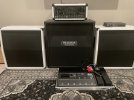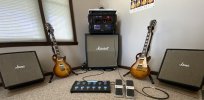sprint
Axe-Master
+1 - another nuance is the amplification used. My on/off interest in wdw has mainly been wrt Brian May's rig. A key to his wdw definition seems to be that he uses 3 Vox AC30s in mix-dry-mix with stereo fx running fx-L into AC30-L and fx-R into AC30-R which gives fx like stereo chorus a more natural sound. This has to be improvised in Axefx given a 2 amp limit but I was able to set it up with Ax2 in the loop of Ax3 and out to 2 pairs of studio monitors (one pair in mono for dry). Sounded great, but I dismantled it as I did not find a huge difference from a well set up stereo preset - was not worth the complexity maintenance for me. Lots of different definitions I guess.Just a random two cents: I've learned something in recent years. The name "wet-dry-wet" is a bit misleading in the context of what some players do: the WET sides can sometimes contain some dry. In these cases, MIX-DRY-MIX might be more appropriate, but then, effects are also sometimes applied to the dry as well in the form of pedals out front that affect the entire rig -- and I don't just mean Drives/EQs/Compressors.
So if you're doing experiments, be open minded.
Last edited:



